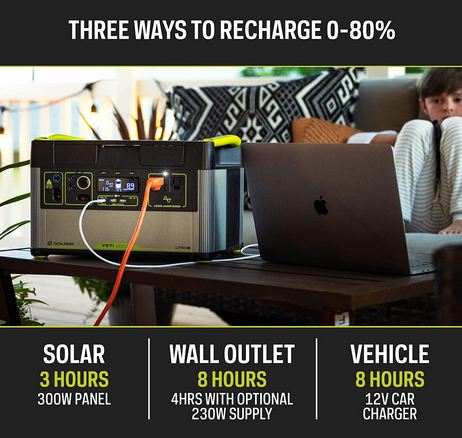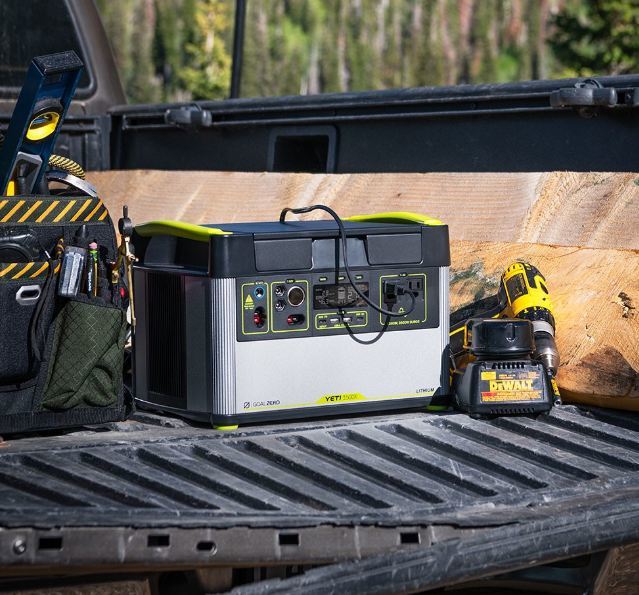Wondering how to recharge your Goal Zero Yeti solar generator?
You’ve come to the right place.
Most power stations, including those from Goal Zero, come with multiple recharge options. This lets you choose the best charging method for different kinds of situations, e.g. when you are at home, when camping, in a blackout and so on.
Similar to most portable solar generators, you can recharge your Goal Zero Yeti solar generator in three ways: a wall outlet, solar power and your vehicle’s 12V outlet.
In this post, we discuss how to use each charging method and how long they take to recharge a Goal Zero power station.
We also include some tips on how to charge your Goal Zero solar generator faster.
How To Charge Your Goal Zero Yeti From A Wall Outlet
The easiest and usually the fastest way to recharge a Yeti power station is from a wall outlet. Goal Zero includes AC chargers with all their solar generators.
Simply plug one end into the AC input port and the other end into a standard wall outlet. Check the display to make sure there is power coming in.
How long it takes to charge a Yeti power station with AC power depends on the specific model you have.
The bigger the Yeti power station, the longer it will take to charge. Different models also come with varying AC chargers. Some have a low-input 60W power supply that takes longer to recharge the battery while others come with a faster charging power supply cable.
For instance, the Yeti 500X (505Wh) takes 10 hours to recharge from a wall outlet. The Yeti 1000X takes 9hrs to charge, and the Yeti 3000X charges in 14 hours.
It’s worth noting that Goal Zero Yeti power stations are some of the slowest charging in the market today. They are outmatched by newer brands like Bluetti and EcoFlow.
For instance, the 3.6kWh EcoFlow Delta Pro has a larger battery than the Yeti 3000X. But it charges in just 2.7 hours from a standard wall outlet.
How To Charge Your Goal Zero Yeti With Solar

All Goal Zero Yeti power stations come with a solar input port that lets you connect solar panels. Solar charging is handy when you are outdoors, on the road, or during a power blackout.
Before charging your Yeti power station with solar, there are two things to check.
Max input power is roughly the same for Yeti power stations. It’s 150W through the 8mm charging port and 600W through the high power port (HPP). One of the exceptions is the Yeti 200X, which accepts up to 100W of solar power.
Tip: Goal Zero says it’s okay to exceed power input with some of their power stations. It increases the likelihood of achieving the max power input, allowing the power station to charge faster.
A 600W solar panel array will not produce 600W of power, but an 800W array might produce the max 600W of input power.
Voltage range is also similar for most of the Yeti X power stations: 14-50V (13-22V for the 200X).
Whether you decide to set up your solar panels in series or parallel, the most important thing is that you don't exceed 50V.
The smaller power stations like the 200X and 500X only have the 8mm power inputs. Starting from the Yeti 1000X and larger, you get both 8mm and HPP input.
If you are using third party solar panels without Goal Zero’s HPP output port, you’ll need an MC4 to HPP/Anderson or an MC4 to 8mm adapter.
If you are using Goal Zero’s solar panels with a HPP port but you are charging one of the smaller Yeti power stations with just an 8mm input, you’ll need a HPP to 8mm connector.
How Long Does It Take To Charge Goal Zero Yeti With Solar?
Solar charging times for Goal Zero Yeti depends on the weather where you are. But Goal Zero gives some approximate times assuming it’s bright and sunny.
The Yeti 200X takes 2-4 hours to charge with a 100W solar module, the Yeti 1500X takes 4-8 hours to charge from a 400W array, and the massive Yeti 6000X takes 12-24 hours to charge from a 600W solar array.
Similar to charging from a wall outlet, we’ve found Yeti power stations to charge slower with solar compared to certain brands in the market.
We’ve reviewed solar generators that accept over 1000W of solar power and can charge in just a couple or so hours.
How To Charge Your Goal Zero Yeti From Your Vehicle
The slowest way to charge your Yeti is from your vehicle’s 12V/24V outlet. It takes well over 12 hours to charge a yet from your car.
That’s why I recommend this method only for emergencies or when you are on the road and want to top up your solar generator.
By the way, Goal Zero doesn't include a car charger in the box. You’ll have to order it separately to use the car charging method.
How To Charge Your Goal Zero Yeti Faster

One of the main limitations of Goal Zero Yeti solar generators is that they charge slowly. Goal Zero has yet to release updated models with faster charging.
That said, there are a few ways to reduce charging time for your Yeti. Here are the best tips to charge your Goal Zero Yeti faster.
Do Goal Zero Yeti Solar Generators Have Dual Charging?
One of the ways solar generators from EcoFlow, Bluetti and other brands manage to charge so fast is that they allow you to combine two charging methods.
For instance, solar and AC.
Unfortunately, Goal Zero Yeti power stations don’t have this feature. You can plug in an AC charger and solar charger at the same time (only for 1000X and bigger models with two input ports), but the power station will only get power from the input with the highest voltage.
Goal Zero says you can connect solar panels to both the 8mm and HPP input ports for models with both ports. But the two arrays have to produce the same voltage. Otherwise, the power station will pick the highest voltage input.
Do Goal Zero Yeti Solar Generators Have Pass-through Charging?
Yes, Goal Zero Yeti solar generators have pass-through charging. You can continue drawing power from the power station while it’s charging.
Note, however, that this will increase charging time. If the battery is low, you may want to unplug any appliances and electronics and wait until the battery has charged a bit.
Pass through charging also generates more heat in the power station, which is not good for lithium batteries. I recommend using this feature sparingly.
Can I Charge Goal Zero Yeti With A Gas Generator?
Yes, you can charge a Yeti power station from a conventional gas generator. This can be handy during an emergency or when you are outdoors.
Charging from a solar generator is no different from plugging your Yeti into a wall outlet. In both instances, you are drawing AC power.
Make sure the gas generator has an AC outlet and that it can handle the required power input.
Can I Leave My Goal Zero Power Station Plugged In?
Yes, you absolutely can. That’s what Goal Zero actually recommends. They say that keeping your power station plugged into a wall outlet or connected to solar panels prolongs battery life and ensures it’s always ready to go.
Remember that Yeti power stations have a built-in MPPT charge controller and battery management system. You will not damage anything by keeping the power station plugged in. It will not overcharge.
If you cannot keep the power station plugged in all the time during storage, the next best option is to recharge it every 3 months.
This keeps the lithium battery from deeply discharging, which can cause permanent battery damage.
How Do I Know That My Goal Zero Yeti Is Charging?
Yeti power stations have an indicator light next to the input. If you’ve successfully connected the charging cable, the indicator light should come on.
You can also check the display at the front of the unit. You’ll see the battery icon blinking, indicating that the battery is charging.
Once it stops blinking, you know the power station is fully charged.
How Long Do Goal Zero Batteries Last?

With every discharge and recharge (called a cycle) of your Yeti power station, its capacity goes down a bit.
It takes about 500 cycles for the capacity of Yeti power stations to fall to 80%. With normal usage, that’s about 2-3 years of use.
Of course, the power station is still usable after this. In total, you can get about 2000 to 3000 cycles (roughly 3-5 years) from your Yeti solar generator before the battery completely dies.
Note that various factors such as temperature and storage conditions can reduce the lifespan of your Goal Zero Yeti power station.
To keep your Yeti functional as long as possible, try to charge it no more than once a day, don't expose it to extreme temperatures, limit your use of pass-through charging, and keep it charged during long term storage.
If you want a longer lasting power station, look for those that use LiFePO4 or lithium phosphate batteries such as the Bluetti AC200P. LiFePO4 batteries can last over 3000 cycles to 80% capacity and up to 5000 cycles or more in total (5-10 years lifespan).


